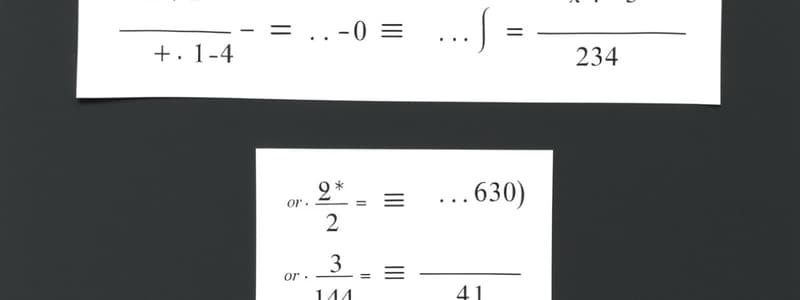Podcast
Questions and Answers
What is a rational expression?
What is a rational expression?
- An expression of the form p(x)/q(x) where p(x) and q(x) are polynomials (correct)
- An expression that contains only variables
- An expression involving only integers
- An expression that cannot be simplified
What does it mean to simplify rational expressions?
What does it mean to simplify rational expressions?
Remove common factors from the numerator and denominator, state restrictions, and simplify.
A rational expression can have a denominator equal to zero.
A rational expression can have a denominator equal to zero.
False (B)
What are the steps for multiplying rational expressions?
What are the steps for multiplying rational expressions?
What is the first step in dividing rational expressions?
What is the first step in dividing rational expressions?
What are the steps for solving rational equations?
What are the steps for solving rational equations?
What is direct variation?
What is direct variation?
In inverse variation, y varies directly with x.
In inverse variation, y varies directly with x.
What is the constant of variation in direct and inverse variations?
What is the constant of variation in direct and inverse variations?
What is the first step in graphing simple rational functions?
What is the first step in graphing simple rational functions?
Which statement is true regarding the horizontal asymptote (HA) of a rational function?
Which statement is true regarding the horizontal asymptote (HA) of a rational function?
How do you find the x-intercept of a rational function?
How do you find the x-intercept of a rational function?
What is joint variation?
What is joint variation?
In combined variations, how does z vary with respect to x, y, and w?
In combined variations, how does z vary with respect to x, y, and w?
What should you do to graph rational functions effectively?
What should you do to graph rational functions effectively?
Flashcards are hidden until you start studying
Study Notes
Rational Expressions
- Defined as an expression in the form of p(x)/q(x) where p(x) and q(x) are polynomials.
Simplifying Rational Expressions
- Remove common factors from the numerator and denominator.
- Identify restrictions to avoid zero in the denominator.
Multiplying Rational Expressions
- Factor all numerators and denominators before multiplication.
- State restrictions and simplify common factors.
Dividing Rational Expressions
- Factor both numerators and denominators.
- Flip the second fraction before proceeding with multiplication.
- Identify restrictions from both the original and flipped denominators.
Adding and Subtracting Rational Expressions
- Determine the least common denominator (LCD) as the highest degree of factors from all denominators.
- Multiply the entire numerator and denominator by the LCD.
- Perform addition or subtraction on the numerators and simplify.
Complex Fractions
- Find the LCD of all involved fractions.
- Multiply numerator and denominator by the LCD, remembering to factor everything first.
Solving Rational Equations
- Find the least common denominator (LCD) and multiply both sides by it.
- Simplify the equation and solve, checking for extraneous solutions.
Solving Proportions
- Ensure there is one fraction on each side before solving.
- Use cross multiplication to solve the equation, checking for extraneous solutions.
Direct Variation
- Represented by the equation y = kx where k ≠ 0.
- Can be expressed as y/x = k, indicating that y changes directly with x.
Inverse Variation
- Expressed by the equation xy = k where k ≠ 0.
- Can also be rearranged to y = k/x, indicating that y varies inversely with x.
Joint Variation
- A relationship where one variable varies directly with two or more variables.
- Example: z varies jointly with x and y, resulting in z = kxy.
Combined Variations
- Combines direct and inverse variations: e.g., z = ky/x signifies direct variation with y and inverse with x.
- Another form could be z = kxy/w², showing joint variation with x and y and inverse with w².
Constant of Variation
- The ratio in direct variation or the product in inverse variation.
Graphing Simple Rational Functions
- General form: f(x) = a/(x+h) + k.
- Vertical asymptote located at h and horizontal asymptote at k.
- Graphing process involves determining asymptotes, plotting points, and analyzing domain, range, and end behavior.
Important Rules for Rational Functions
- A rational function in standard form is f(x) = p(x)/q(x).
- Horizontal asymptote rules:
- Bottom heavy (q(x) > p(x)): HA is y = 0.
- Balanced (p(x) = q(x)): HA is y = (lead coefficient of p)/(lead coefficient of q).
- Top heavy (p(x) > q(x)): No HA, may have slant asymptote.
- Vertical asymptotes identified by unique factors of the denominator, while holes arise from common factors.
Simple Rules for Rational Functions
- Factors provide insight into vertical asymptotes, x-intercepts, and holes.
- To find x-intercepts, set f(x) to zero; for y-intercepts, compute f(0).
Graphing Rational Functions in Standard Form
- Steps involve finding vertical/horizontal asymptotes, intercepts, and then graphing while considering sign tables for accuracy.
Writing Rational Functions in Standard Form
- Involves constructing functions rooted in the definitions and procedures outlined for understanding and simplifying rational expressions.
Studying That Suits You
Use AI to generate personalized quizzes and flashcards to suit your learning preferences.



